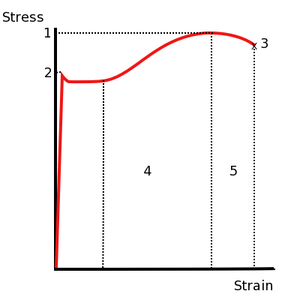A-level Physics (Advancing Physics)/Stress, Strain & Young's Modulus
< A-level Physics (Advancing Physics)Stress
Stress is a measure of the internal force an object is experiencing per unit cross sectional area. Hence, the formula for calculating stress is the same as the formula for calculating pressure: but
where σ is stress (in Newtons per square metre or, equivalently, Pascals). F is force (in Newtons, commonly abbreviated N), and A is the cross sectional area of the sample.
Tensile Strength
The (ultimate) tensile strength is the level of stress at which a material will fracture. Tensile strength is also known as fracture stress. If a material fractures by 'crack propagation' (i.e., it shatters), the material is brittle.
Yield Stress
On a stress strain graph beyond the yield point (or elastic limit) the material will no longer return to its original length. This means it has become permanently deformed. Therefore the yield stress is the level of stress at which a material will deform permanently. This is also known as yield strength.
Strain
Stresses lead to strain (or deformation). Putting pressure on an object causes it to stretch. Strain is a measure of how much an object is being stretched. The formula for strain is:
,
where is the original length of a bar being stretched, and l is its length after it has been stretched. Δl is the extension of the bar, the difference between these two lengths.
Young's Modulus
Young's Modulus is a measure of the stiffness of a material. It states how much a material will stretch (i.e., how much strain it will undergo) as a result of a given amount of stress. The formula for calculating it is:
The values for stress and strain must be taken at as low a stress level as possible, provided a difference in the length of the sample can be measured. Strain is unitless so Young's Modulus has the same units as stress, i.e. N/m² or Pa.
Stress-Strain Graphs

Stress (σ) can be graphed against strain (ε). The toughness of a material (i.e., how much it resists stress, in J m-3) is equal to the area under the curve, between the y-axis and the fracture point. Graphs such as the one on the right show how stress affects a material. This image shows the stress-strain graph for low-carbon steel. It has three main features:
Elastic Region
In this region (between the origin and point 2), the ratio of stress to strain (Young's modulus) is constant, meaning that the material is obeying Hooke's law, which states that a material is elastic (it will return to its original shape) if force is directly proportional to extension of the material
Hooke's Law
Hooke's law of elasticity is an approximation that states that the Force (load) is in direct proportion with the extension of a material as long as this load does not exceed the proportional limit. Materials for which Hooke's law is a useful approximation are known as linear-elastic
The relation is often denoted
The work done to stretch a wire or the Elastic Potential Energy is equal to the area of the triangle on a Tension/Extension graph, but can also be expressed as
Plastic Region
In this region (between points 2 and 3), the rate at which extension is increasing is going up, and the material has passed the elastic limit. It will no longer return to its original shape. After point 1, the amount of stress decreases due to necking at one point in the specimen. If the stress was recorded where the necking occurs we would observe an upward curve and an increase in stress due to this reduction in area(stress = Force / area, thus stress increases during necking). The material will now 'give' and extend more under less force.
Fracture Point
At point 3, the material has been fractured.
Other Typical Graphs
In a brittle material, such as glass or ceramics, the stress-strain graph will have an extremely short elastic region, and then will fracture. There is no plastic region on the stress-strain graph of a brittle material.
Questions
- 100N of force are exerted on a wire with cross-sectional area 0.50mm2. How much stress is being exerted on the wire?
- Another wire has a tensile strength of 70MPa, and breaks under 100N of force. What is the cross-sectional area of the wire just before breaking?
- What is the strain on a Twix bar (original length 10cm) if it is now 12cm long?
- What is this strain, expressed as a percentage?
- 50N are applied to a wire with a radius of 1mm. The wire was 0.7m long, but is now 0.75m long. What is the Young's Modulus for the material the wire is made of?
- Glass, a brittle material, fractures at a strain of 0.004 and a stress of 240 MPa. Sketch the stress-strain graph for glass.
- (Extra nasty question which you won't ever get in an exam) What is the toughness of glass?
- Wire has a tensile strength of 0.95Mpa, and breaks under 25N of force. what is the cross-sectional area of the wire before and after breaking?